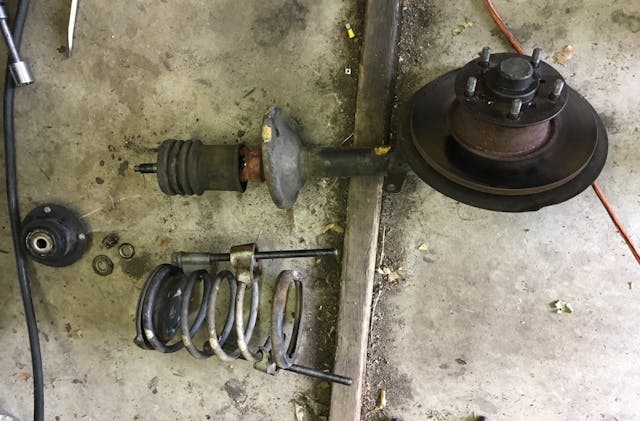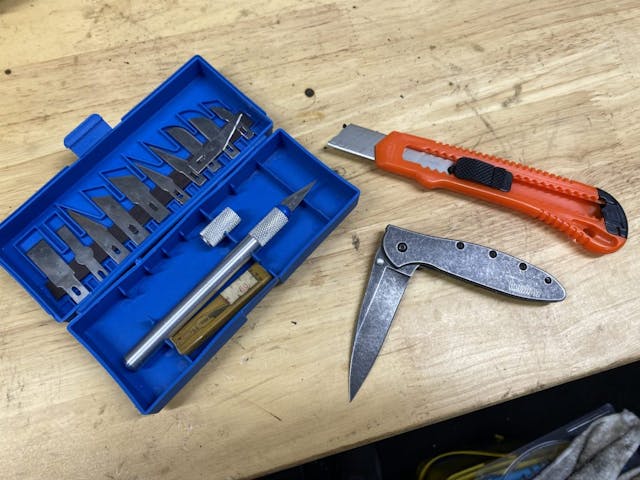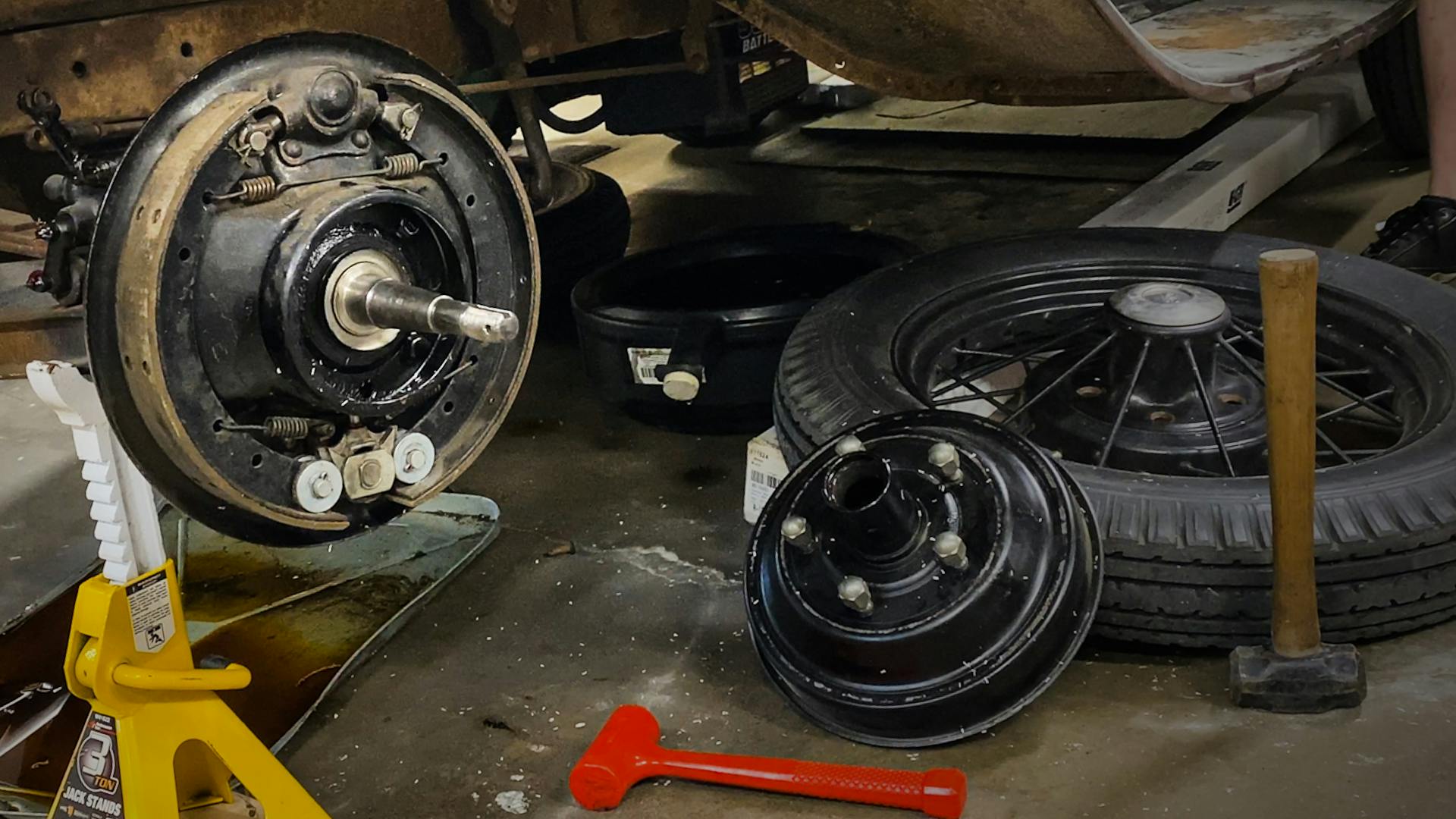8 of the most lethal tools in your home shop
Working on cars is inherently dangerous. Just like driving, spinning wrenches on a vehicle requires respect and undivided attention. We all accept a certain amount of risk when taking on DIY projects, and I’m willing to bet that the percentage of people who have left every single one of their projects without a scrape or bruise to be less than one. I won’t go so far as to say everything is dangerous, but here are a few repeat offenders that I think are the most dangerous tools in the average shade tree mechanic’s shop.
Drill press/drill

Even small drill presses are high-torque affairs thanks to speed reduction pulleys. Snag something on a drill bit and the machine will continue to wrap that material until you hit the stop switch. When drilling, remember that the most dangerous time is right before the bit breaks through the backside of the material. Should the tooling bite, rather than cut, it will take whatever you’re working on and whip it into oblivion. A vise will hold your workpiece in place, but used with a hand drill, you run the risk of twisting your wrist. Still, holding a piece in your hand and drilling on the drill press is asking for trouble. Get a drill vise or appropriate clamps and use them.
Remember, speeds and feeds are incredibly important when drilling. Make sure to adjust the speed at which the drill is spinning and monitor the feed, or the rate as which the drilling takes place.
Grinder

Handheld grinders can easily spin a 4.5″ disc to 8000 rpm and are used to remove material from your project. That material is coming off the wheel at Mach Jesus and bouncing about your shop. Without due care that material will bounce right back at you or damage delicate parts of your project, or worse, your eyes. Questionable quality discs can also break apart and become projectiles in every direction. Grinders are powerful tools to be used with respect and care as to where the material is going. It’s best practice to to use quality attachments, combined with good personal protective equipment: safety glasses, hearing protection, and gloves, at a minimum.
Spring compressor

Hell hath no fury like a compressed spring unintentionally released. Literally tons of force can be sprung loose in an instant. The suspension in our beloved car is sometimes one slip of a wrench from shooting out big parts at ballistic speeds. When working with spring compressors a big dose of extra caution is warranted.
Consider taking a “belt and suspenders” approach by not only carefully using the proper tool, but also using chain to retain the spring to a solid part of the vehicle like the frame, so that if energy is released it will still be contained to an area that you are choosing and can then stay out of. Spring compressors tend to be extra dangerous because often times they are rented tools rather than purchased, and come with few instruction on how to safely use. Do your research on the safe use of spring compressors, and know your limits on when it is time to call in the professionals.
Trash can

Seriously. Have you ever seen that video where a Christmas tree catches fire and it’s only seconds before the whole room is ablaze? That can happen with your shop trashcan too. More than a few projects involve any number of chemicals and it only takes two of the wrong ones to mix in you trash can before they spontaneously combust. We haven’t even talked about the danger of drying oils which can oxidize and create enough heat to self-ignite. Throwing rags in your trash can is asking for trouble. the better move is to get a fire-rated canister with a lid that serves to not only contain any fire, but also limit the access to oxygen that is required to stoke the fire in the first place.
Your ego
One of the most powerful and dangerous tools is your own brain. Confidence comes in one of two ways: experience or ignorance. Walk into a job with the latter and it’s only a matter of time before you are hurt and wondering what happened. Using tools improperly or taking shortcuts are surefire ways to end up damaging your project and/or your body. Check you ego at the garage door, and a safer—and more fun—time will be had by all.
Jack

Floor jacks are fascinating tools once you understand how leverage and hydraulic physics. The ability to easily lift thousands of pounds is a superpower possessed by anyone with a $100 bill. That is terrifying, if you consider the dangers involved. Lifting a car requires attention to proper jacking points and also proper support once up in the air. Again, the physics are amazing, but even more amazing is that all that hydraulic pressure often rests on just a few five-cent o-rings. Do you trust your life to an o-ring? I didn’t think so. Use jack stands. Every time.
Any knife

This is a strange one to explain to folks who haven’t experienced it before, but sharp knives are the safe ones. Dull cutting edges require additional force to push through material and thus have a tendency to slip or turn in a direction the user didn’t intend. Combine this with bad habits like cutting towards ourselves (I’m guilty of this more than I would care to admit) and you have a recipe for disaster. Grab a whetstone and put a fresh edge on your sharp things. I promise that is actually safer.
Punches

When using a punch or chisel you are likely scared of the hammer blows and the chance of hitting your holding hand. That’s a real fear, but the chisel itself may conspire to hurt you as well. The end of a punch that receives those carefully placed hammer strikes has a tendency to mushroom slightly and can reach a point where the edge becomes brittle. When struck, it becomes a sharp projectile. This is easily prevented by filing down any mushrooming edges on your punches.
In the wrong hands anything can be dangerous, just ask my friend who has a glass eye about how dangerous a screwdriver can be when used incorrectly. That doesn’t mean you should never go out and enjoy working on your car though. Everything in life comes with risk, but mitigating some of that by acting responsibly is never a bad idea. Think there is another tool in a common home shop that presents more risk? Leave us the details in the Hagerty Community below.





Thanks for this important article!
The most versatile tool in the toolbox, or kitchen drawer, the screwdriver. Functions as a prybar, hand or hammer-driven punch, scraper, circuit-jumper, can opener, paint stirrer, easily modified with a grinder as an awl, unlimited possibilities. Who hasn’t experienced a screwdriver puncture wound, and who has chosen to forget/disregard the experience(s)?
Are chlorinated solvents in brake cleaners still out there? Burn some and it makes phosgene gas.
Needle nose pliers have hurt me the most. I cannot tell you how many blood blisters have occurred using a pair on needle nose pliers that inevitably slipped and pinched the base of my index finger. Or am I the only one this has happened to?
You’re not alone! I was thinking the other day that I should figure a way to modify those so that it won’t happen again. It just hurts SO MUCH.
Air compressor can be quite dangerous also.
Compressed air AND compressed hydraulic fluid are not to be trifled with…I spent 34 years in aircraft maintenance with USAF/ANG and have seen some horrible results from “horseplay” and negligence by supposed adults resulting in injuries and maiming. Not a pretty sight.
I’m a retired mechanic, fifty years spinning wrench’s, I worked on all modes of transportation, seen just about every kind of accident that can be imagined, most happened by not following protocol, taking short cuts, bullshitting instead of concentrating on what your doing, tools don’t kill, working with your head up your ass will.
Had two accidents listed here – used compressed air on a wheel bearing, new better but “in a hurry, getting late, got to finish this up…), blew apart in my fingertips. And spring compressor – kneeling down next to it, turn the ratchet & one of the “fingers” broke, sent it directly into my knee & then right into the open wheel well of the car. Luckily didn’t do any damage to the car & only got a sore knee for a day. Main lesson on that one was don’t buy cheap on certain tools. Went to a pasts supplier the next day & bought a decent set that had a safety pin in them. And once I got it compressed so far, used a small length of chain & connectors as a backup.
Hearty congratulations for, once in a while, running the kind of discussion thread you’d *expect* to see from your insurance company! I like to excerpt these for our chapter newsletter articles, but too many members get heebie-jeebie flashbacks and can’t finish the column. You can really tell when your readership has real-world experience.
So many things I could warn about and I’m guilty of pushing my luck way too often. One not mentioned was wire wheels; I always wear glasses with them. The wires can fly out and get you. Also, not as dangerous, but a wire wheel in a drill can grab your t-shirt and wad it up in an instant. Kind of funny but can still hurt.
I am always amazed at how many guys or gals will grab a can of spray paint and go after something while wearing no goggles. Even professional car painters in bunny suits and wearing respirators, but nothing over their eyes. Not a good idea.
When removing a wheel for brakes or suspension work, I like to shove it under the car for a secondary jack stand if things go fruity. It also gets the wheel out of the way.
All of these comments brought back memories. Here is a news item (from Florida): a murder was committed with an angle grinder. I wonder what he cut off.
Back when, I had limited welding experience and was foolishly allowed near the gas welder in the Army motor pool. Succeeded in causing a blast at the hose end of the handle that went back to the end of the oxy hose. Never saw a bunch of guys evacuate a building so fast.Learned a lot since.
Thank you for not using my name when you wrote my biography above
The wire wheel used for cleaning up parts is also dangerous unless you are wearing eye protection and have a good clamp on the part being cleaned.
The solution is simple and costs nothing:
Pay Attention.